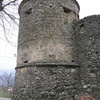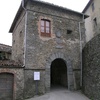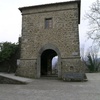Fort of Cascio
The village of Cascio is on the top of a hill along the eastern slopes of Mount Altissimo, in a privileged position that allows views not only of the confluence of the Corsonna and Serchio rivers, but also of other fortified towns such as Castelvecchio, Albiano, Barga and Mologno.
The town still has large portions of walls built in the 17th century by the military architect Pasio Pasi.
The main place of worship of the village is the Church of Saints Stephen and Lawrence and inside you can find an interesting terracotta by Andrea Della Robbia depicting the Madonna and Child.
Historical notes
The first evidence of a "Loco Cascio" dates back to 834. Scrolls from Lucca inform us that it was only from 997 that the small housing cluster became part of the parish of San Cassiano Gallicano and that in ancient times, at least since 904, was equipped with its own "ecclesia" dedicated to St. Stephen.
A parchment dating from 1062 enumerates "Cassio" among the towns under the joint authority of the Suffredinghi family and the Porcaresi family, who were most likely responsible for the first fortification of the site between the 11th and 12th centuries.
Just outside the town there was also another place of interest, which in ancient times was known as "Locus Dominarum" di Cascio. This is a convent, with adjoining church and hospital, originally dedicated to St. Andrew and later Saint Mary Magdalene. The church building and the "Monastery of Cascio Carfagniane", noted in various sources from at least 1257, lie to the north of the castle and were counted among the dependencies of the parish of Gallicano in 1260 and later in 1387.
Throughout the 14th century, Cascio was not once mentioned as a fortification: in 1376 it was listed among the "communia", or communities of Garfagnana and not among the "castella", or castle-towns. The town was also one of the municipalities that in 1308 had to participate in the procession of the Holy Cross as an act of submission to the City of Lucca.
Following the struggles between Lucca and Florence during the fifteenth century, the town was placed under the authority of the Duke of Este and incorporated into the Vicariate of Trassilico. Under the House of Este the town was fortified with new walls. However, much of the town and fortifications built in the 17th century suffered extensive damage during the winter of 1944, when for seven months the town found itself on the German-American front.











